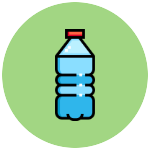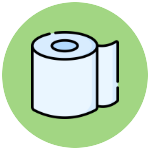
This resource is available as a printable fact sheet
- Click the "Generate PDF" button
- Select "Save as PDF" from printer destination setting and check "enable background graphics"
- Click print to download a PDF copy to your computer.
Generate PDF
Or, save paper and print as a quick access QR code for your fridge, desk or purse!
Table of contents
What is constipation?
Bristol stool chart
How does constipation happen
How is constipation treated
Other things you can do at home to help
What is constipation?
Constipation is when stool builds up in the bowels and causes discomfort. It can happen even if a child has a bowel movement (BM, stool or poop) every day. You might feel a little embarrassed about this, but constipation happens to most children at some point. The good news is that constipation is rarely caused by a serious illness. By the time you notice symptoms, constipation has usually been a problem for a while, and may take months to get better. Having a large amount of stool in the bowels causes them to become larger than normal, making it harder for the bowel muscles to empty stool. The bowel will get back to a more normal size if the stool is cleared and doesn’t build up again over the next 3-6 months.
A child or youth with constipation may:
- have stool that is hard or painful to pass
- have very large stool (sometimes needing a plunger to flush)
- have stool that is type 1, 2 or 3 on the Bristol stool chart
- suffer with stomach pain or cramps (these can be severe)
- have trouble passing urine (going pee)
- need to pass urine (go pee) more often
- have blood in their stool
- have problems with behaviour
- have stool that leaks into their underwear
- have problems with behaviour
Bristol stool chart
| Looks like | Description |
|---|---|
| Type 1: separate hard lumps like nuts (hard to pass) | |
| |
Type 2: sausage-shaped but lumpy |
| Type 3: like a sausage but with cracks on its surface | |
| |
Type 4: ideal consistency, like a sausage or snake, smooth and soft |
| |
Type 5: soft blobs with clear-cut edges (passed easily |
| |
Type 6: Fluffy pieces with ragged edges, a mushy stool |
 |
Type 7: watery, no solid pieces, entirely liquid |
How does constipation happen?
Slowing of the bowels causes stool to become hard, dry, and difficult to pass. This sometimes causes a large mass of impacted stool in the rectum (the part of the bowel that holds stool). Stool builds up behind the impaction and may leak liquid stool out of the anus, soiling a child's underwear. The exact cause is often not known, but it may be due to:
- not eating enough fibre, vegetables, fruits, and grains
- not getting enough physical activity
- some medications (antacids, opiate pain medications, anti-depressants)
- holding in stool (‘withholding’) when they are feeling stressed about potty training
- delaying going to the toilet when feeling the urge to ‘poop’ when they are too busy playing, or are embarrassed or afraid of using a school or public toilet
- allergies to milk or eggs
Contact your health-care provider if your child or youth
- has severe pain or pain lasting longer than 30 minutes
• gets a fever • has vomiting
• loses weight
• wakes up from sleep to pass stool
• keeps crying and you can't soothe them
• develops cracks in the skin around the anus (anal fissure)
• has intestine drooping out the anus (rectal prolapse)
• is still having problems with constipation after following the above plan for two weeks
• has lots of blood in the stool
How is constipation treated?
Children and youth usually need medication for a few months, along with some other steps to resolve constipation. They can take medication by mouth or through the rectum (bum). We usually suggest medications by mouth. You won’t need a prescription, but you may have to ask the pharmacist for these medications.
Step 1: PEG3350 bowel clean out
The first step is to clean out the bowels using an oral laxative that has polyethylene glycol 3350 (PEG3350). Not all laxatives have this key ingredient, so read the label carefully. Some common brands that have PEG3350 are Lax-aDay®, Restoralax®, Relaxa® and Clearlax®. The amount you give depends on your child or youth's weight. After three days, move on to step two to help retrain the bowels and prevent further constipation. This is very important even if your child has been in distress for only a few days.
| Weight | Dose of PEG3350 | Frequency |
|---|---|---|
| 7-10 kg | 2 tsp in 100 mL fluid | Twice a day for 3 days |
| 11–13 kg | 3 tsp in 150 mL fluid | Twice a day for 3 days |
| 14–19 kg | 4 tsp in 200 mL fluid | Twice a day for 3 days |
| 20–34 kg | 5 tsp in 200 mL fluid | Twice a day for 3 days |
| 35-50 kg | 5 tsp in 200 mL fluid | Three times a day for 3 days |
| 50+ kg | 10 tsp in 200 mL fluid | Three times a day for 3 days |
Step 2: retrain the bowels and prevent constipation
- continue giving your child or youth PEG3350 to get them back to a normal pattern of bowel movements
- check your child’s stools (use the Bristol stool chart)
- decrease the dose of medicine if the stools are very loose or your child or youth gets cramps
- continue this medication for longer than two months if the constipation doesn’t get better
| Weight | Dose of PEG3350 | Frequency |
|---|---|---|
| 7–10 kg | 2 tsp in 100 mL fluid | Once a day for 2 months |
| 11–13 kg | 3 tsp in 100 mL fluid | Once a day for 2 months |
| 14–17 kg | 4 tsp in 100 mL fluid | Once a day for 2 months |
| 17+ kg | 5 tsp in 100 mL fluid | Once a day for 2 months |
Treatments that are not effective for constipation once it has become a problem
There is no research evidence to support the use of these treatments): pre-biotics or probiotics, intensive behavioural therapy and other alternative treatments.
Other things you can do at home to help

Give a healthy diet
Vegetables, fruits and grains are good sources of fibre. The amount of fibre needed each day depends on your child’s age. See Canada's Food Guide for the number of servings of vegetables, fruits and grains your child should have each day. Each meal and snack should include a fibre rich food. Increase fibre in your child’s diet gradually. Make sure to increase fluids at the same time.
You might want to take all milk or egg out of the diet for at least two weeks, in case there is an allergy.

Increase fluids
• A 10 kg (22 lb) child needs 1 litre (4 cups) each day.
• A 20 kg (44 lb) child needs 1.5 litres (6 cups) each day.
• A 45 kg (99 lb) child needs 2 litres (8 cups) each day.
Toddlers should have just 2-3 cups of milk each day. The rest of their fluid intake should be water. Limit juice, as it can cause cramping and gas.

Regular toileting
It can take weeks or months to train the bowel back to a normal pattern. Take advantage of the body’s normal urge to empty after meals. 20-30 minutes after each meal at home, have your child sit on the toilet or potty for one minute for each year of age (for example, three minutes for a three-year-old). Give your child a foot stool if needed. This will make your child more comfortable and give them some support to let go of a bowel movement. Join your child to read a book together or chat and catch up! Younger children may like stickers on a chart for sitting on the toilet after each meal.
Keep a diary of:
• how often your child has a bowel movement
• the type of stool your child has (check the Bristol Stool chart and record the stool type)

More physical activity
Regular physical activity helps stimulate normal bowel function and keeps the bowel healthy. Children need at least one hour of moderate physical activity each day. For more information, check out Canada’s Physical Activity Guide to Healthy Living.

Test
Hello this is a test to see about this content




